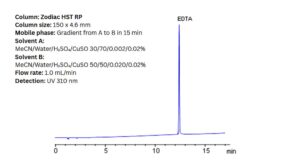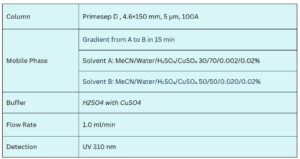
Description
EDTA (Ethylenediaminetetraacetic acid) is an amino acid–based compound widely used across various industries, including industrial cleaners, detergents, photography, agrochemicals, textiles, and food manufacturing. It also serves as a preservative in packaged foods, vitamin supplements, and pharmaceutical formulations. In analytical and organic laboratories, EDTA is commonly used as a metal scavenger, buffer component, complexometric titration agent, and metal masking agent.
EDTA is highly polar with strong chelating properties, making its analysis by HPLC challenging due to low UV activity and strong metal ion binding. A reproducible and robust method has been developed for quantifying a wide range of EDTA concentrations using the Zodiac HST RP mixed-mode anion-exchange column. To enhance detection sensitivity, copper sulfate is employed, forming a UV-active complex with EDTA. This approach ensures accurate quantitation across various formulations and matrix compositions, delivering excellent peak shape and controlled retention.
Proper column equilibration is crucial for consistent retention times. The Zodiac HST RP column has a high ionic capacity for anions. It is shipped in a solvent mixture of ACN/water/TFA, and the final gradient typically contains only 4 mmol of sulfate ions, requiring extended equilibration—often exceeding 5 hours with such low ionic strength.
Before running your experiments to ensure stabillity and reproducibility:
Flush the column with 20% acetonitrile and 0.2% sulfuric acid for 1 hour before starting your analysis.
If you’re not changing the ionic modifier in your mobile phase, allow 4–5 column volumes for full equilibration.
Following this protocol ensures reliable performance and high-quality results when analyzing EDTA with the Zodiac HST RP column.
Condition

Column Name : Zodiac HST RP
Compound Name : EDTA or Ethylenediaminetetraacetic acid
Get Your Quote or Call: 040-29881474
We focus on supporting laboratory workflows & optimizing lab-wide operations
